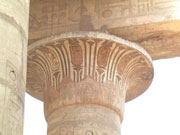TOUR NEWS - GREECE SEPTEMBER 2010
In September 2010 B.C. Archaeology Travel ran its inaugural tour of ancient Greece. The tour ran from the 3rd to the 21st September and explored many of the principle sites of the Greek mainland and the islands of Crete and Santorini. We had a very enthusiastic group most of whom had been on previous tours with the company. The group included: Robert Snow, Margaret Debenham, Lynette Heilbronn, Suzette Etherington, Philippa Shaw, Vesna James, Roma Dix, Carol Cox-Devore and her sister Denise McKenzie, Allan and Helen Hill, Paul and Lindsay Blackburn-Hart, Kerry and Janet Peadon, Chris and Kim Shephard, Toni Messiter and Radek Lasota, Terry and Janette Hartley, and Bryan and Caroline Riddell. The tour was led by me, Michael Birrell, and we had a number of local Greek guides accompany us at the sites.
I arrived a few days before the rest of the group to prepare for the program and had the opportunity to visit the new Akropolis Museum which had not yet opened when I was in Greece the previous year. Many members of the group came early and we caught up for dinner a few times - the view from the roof of the Plaka Hotel is incomparable and provides a clear view of the Akropolis illuminated in the evening.
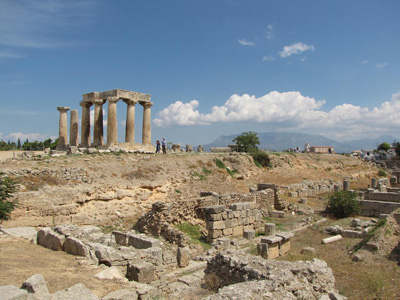 |
 |
Temple of Apollo at Corinth |
Tholos tomb at Mycenae |
The main group arrived in Athens in the morning of the 3rd September and we assembled at the airport to met up with them and board our bus. We travelled the short distance around Athens to Corinth where we saw the ruins of this important Greco-Roman city. The Doric temple of Apollo is well preserved and the onsite museum contains interesting sculpture from the region. We had lunch in a local cafe and then in the afternoon we headed to the picturesque seaside town of Nauplion where we checked into the Hotel Agamemnon - this was our base for the next 4 days.
The following morning we travelled north to the fascinating site of Nemea which is dominated by the recently reconstructed Temple of Zeus. Nemea was the site of an important pan-Hellenic athletic festival and we saw the nearby stadium which still retains evidence of the original mechanism which operated the starting gates. We drove a short distance to Mycenae where we had a picnic lunch. We saw the impressive Late Bronze Age city and tombs. The enormous tholos tombs are particularly impressive as is the famous �Lion Gate�, and we enjoyed the descent into the famous �water tunnel� by torch light. The site museum is excellent and has a fine collection of artefacts from the excavations.
 |
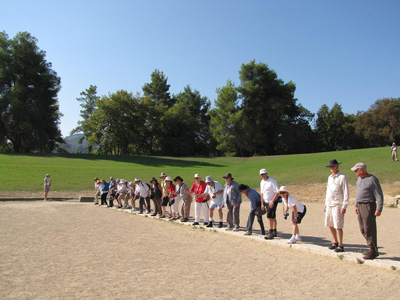 |
The theatre at Epidauros |
The Olympians! |
On the 5th of September we visited the Nauplion Museum which has recently been revamped and is well laid out and labelled - artefacts include suits of Mycenaean armour and numerous grave goods from the area including boar-tusk helmets. In the afternoon we had some free time. Some members of the group went to see the antiquities in Argos, while some of us climbed to the summit of the Venetian castle with its superb views over the Gulf of Argolis. The following morning we headed to the site of Epidauros, home of a major cult to the healing god Asclepius. A highlight of the visit was the magnificent theatre, one of the best preserved from the ancient world. Much of the sanctuary of Asklepius is being restored including the tholos temple and sleeping quarters. We also saw a Mycenaean bridge. After lunch we visited the ruins of Tiryns, with its splendid Mycenaean city walls and palace. Most impressive are the corbelled storage rooms and the well defended gates.
From Nauplion we drove across the Peloponnesus to the site of Olympia. Our road took us through some spectacular mountainous territory. We checked into the Hotel Europa and after lunch at a restaurant in town we explored the excellent site museum of Olympia which contains a superb display of the restored pedimental sculpture from the temples as well as numerous artefacts and statues from the sanctuaries. In the afternoon we enjoyed a swim in the hotel pool. The next day we explored the archaeological remains of Olympia, a large site with many well preserved buildings. Most impressive are the tholos temple and the Doric Temples of Hera and Zeus. The Olympic running track also gives the visitor a good impression of the ancient games - we recreated the start of the race but kept our clothes on! In the afternoon we drove to Delphi, crossing the impressive new suspension bridge over the Gulf of Corinth. The route is very scenic. We checked into the Arion Hotel and had dinner in a restaurant with views looking down over a wide valley leading to the sea.
The 9th of September was set aside for our exploration of ancient Delphi - we walked up through the ancient sanctuary exploring the remains of numerous �treasuries� to the Temple of Apollo, god of light and music. We then continued further up to see the magnificent theatre and stadium. We had a light snack and then explored the lower sanctuary with its distinctive tholos temple and gymnasium.
The next morning we visited the site museum of Delphi. The sculpture from the site is superb, and ranges from archaic kouroi statues to the famous bronze �charioteer�. In the afternoon we left Delphi and headed south to Athens airport where we caught our flight to Iraklion in Crete. We checked into our hotel in the centre of town which was our base for the next 2 nights.
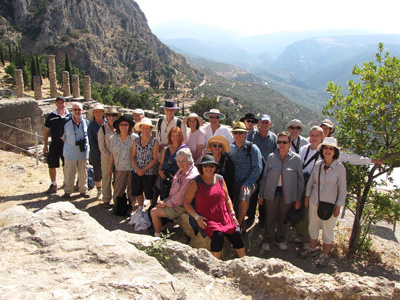 |
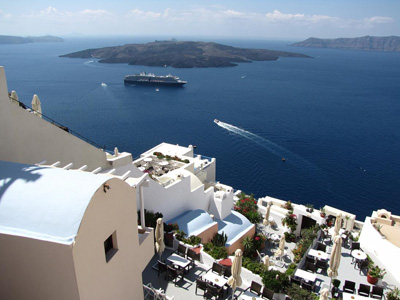 |
The group at Delphi |
The spectacular view over the Santorini caldera |
On the 11th September we visited the ruins of the ancient Minoan palace of Knossos, located on a low hill overlooking a scenic valley. The palace remains are spread over a wide area and were extensively �restored� by Arthur Evans in the late 19th Century - not everyone thought it was sympathetic! In the afternoon we saw the temporary Iraklion archaeological museum which contains an impressive collection of artefacts from the Minoan palace sites (the main Museum is closed for a refit and will open soon).
The next day we headed into the interior of Crete, passing through some very scenic country on our way to the archaeological sites of Phastos and Aghia Triadha. The first site is a major Minaon palace with a spectacular view of the snow capped mountains in the distance; the private rooms of the palace are particularly well preserved. Aghia Triadha is a small Minoan palace near the coast with many well preserved rooms. In the late afternoon we headed to the ferry wharf in Iraklion for our evening ferry to Santorini. The 80 km trip took about 3 hours. Santorini is a flooded volcano and one approaches the main ferry stop as the towering cliffs rise above you. We checked into the Panorama Suites which offered spectacular views - our rooms were cut into the pumice and had vaulted ceilings!
The following day was set aside for rest, with time to explore the many wonders of Santorini. Some members of the group took a boat trip out to the active volcano in the centre of the harbour, while others went for a walk along the edge of the volcano rim for magnificent views of the entire caldera. There was time to explore the numerous shops in the town, and to otherwise relax with a book, or enjoy the splendid views from the hotel. The next day we saw some of the remarkable archaeological heritage of Santorini. We visited the spectacularly sited Hellenistic ruins of Thera. Built by a colony from Sparta, the town was located for protection on the summit of a precipitous rock. In the afternoon we saw the Fira Archaeological Museum which contains numerous artefacts and frescoes from the Minoan settlement of Akrotiri (currently closed for a restoration).
On the 15th September we flew to Athens and checked into the Hermes Hotel located in the fascinating Plaka district. We had 5 fascinating days in this wonderful city. During this extended stay we toured the remarkable collection of antiquities held in the National Archaeological Museum including the Mycenaean treasures, the wonderful sculpture, the extensively re-vamped collection of Greek pottery and the display of wall paintings and artefacts from Akrotiri on Santorini. A day was also set aside to visit the Akropolis of Athens and the newly opened Akropolis Museum. Our walk began with a visit to the Temple of Olympian Zeus at the base of the Akropolis. We then saw the Theatre of Dionysus and the Asclepius Shrine, before climbing to the summit of the Akropolis to see the recently restored Parthenon and the Erechtheion. The Temple of Athena Nike has recently been re-erected. The views across the city were stunning. The new Akropolis Museum contains a stunning collection of sculpture from the area.
While in Athens we also went for a walk through the Athenian Agora, the ancient heart of the city. This fascinating area retains numerous ancient structures from the classical period including the superb Temple of Hephaestus. The Agora Museum in the reconstructed Stoa of Attalus contains a wonderful selection of artefacts from the Agora area.
 |
 |
The newly reconstructed Temple of Athena Nike |
The Temple of Poseidon at Sounion |
From Athens we visited the beautiful island of Aegina, located a short ferry ride away in the Saronic Gulf. We explored the ruins of the fortified Bronze Age city near the port, including the temple of Apollo, and then made our way across the island to see the beautiful Temple of Aphaia. This superb Doric shrine is located on a high point overlooking the sea and is very well preserved. We also travelled North East of Athens to visit the site of the Battle of Marathon and saw the tombs of the Athenians and Plataeans - it was fascinating to see the skeletons of the Plataean soldiers who had died in the battle.
Our final visit was to the south coast of Attica to visit the remains of the picturesque Temple of Poseidon on the end of Cape Sounion. This beautiful Doric shrine was designed as a prominent landmark which could be seen from the sea and hence give aid to travellers of the Aegean. It commands a stunning view across the Saronic Gulf. Our group had enjoyed the major highlights of the history of Greece very much.
After the end of the tour I had a few days in Athens to visit some of the numerous additional museums including the impressive Byzantine Museum, the Cycladic Museum and the Benaki collection of icons. Then Kerry and Janet Peadon and I went north from Athens by bus to Kalambaka to visit the mediaeval monasteries at Meteora. Six complexes survive, all of them perched on the top of precipitous rocks for protection. It was amazing to see the painted chapels and see some of the manuscripts which have survived from the 8th and 11th Centuries including a copy of the Byzantine Suda (a type of encyclopaedia) and the plays of Aristophanes. I ended up staying 5 nights and had the chance to visit the monasteries a few times at different times of the day - a remarkable experience!
Michael Birrell
